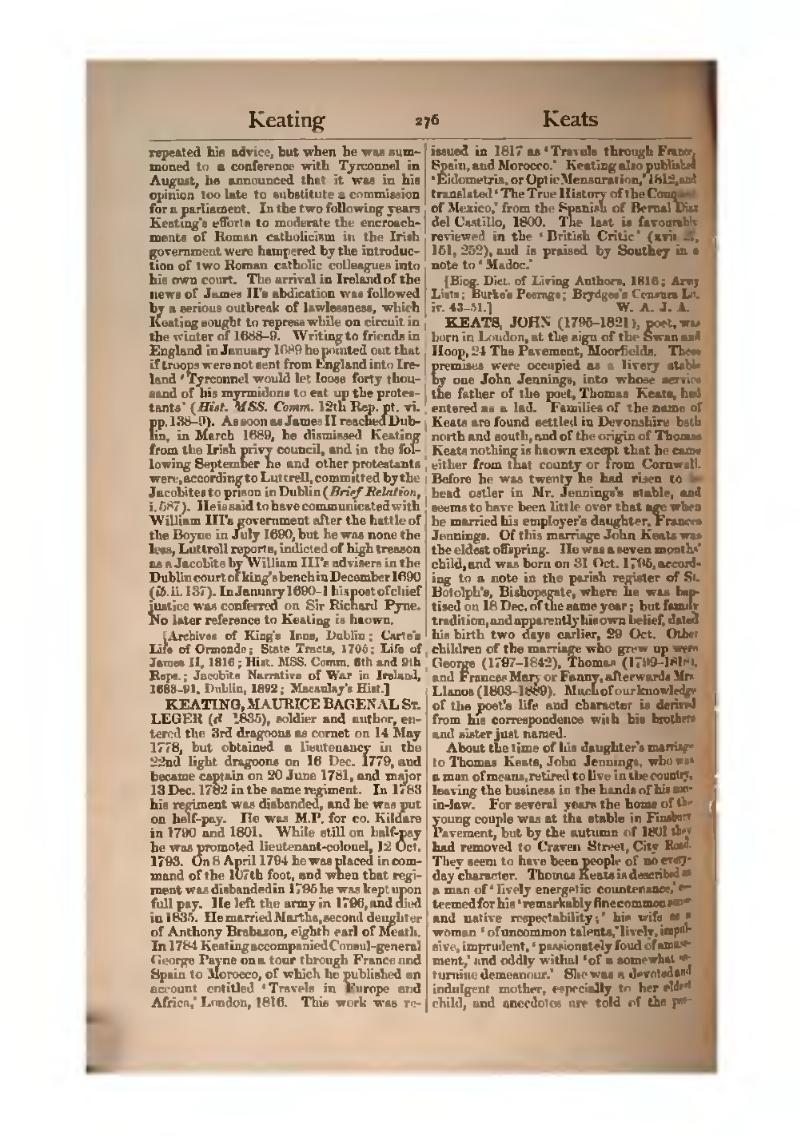repeated his advice, but when he was summoned to a conference with Tyrconnel in August, he announced that it was in his opinion too late to substitute a commission for a parliament. In the two following years Keating's effor ts to moderate the encroachments of Roman catholicism in the Irish government were hampered by the introduction of two Roman catholic colleagues into his own court. The arrival in Ireland of the news of James II's abdication was followed by a serious outbreak of lawlessness, which Keating sought to repress while on circuit in the winter of 1688–9. Writing to friends in England in January 1689 he pointed out that if troops were not sent from England into Ireland ‘Tyrconnel would let loose forty thousand of his myrmidons to eat up the protestants’ (Hist. MSS. Comm. 12th Rep. pt. vi. pp. 138–9). As soon as James II reached Dublin, in March 1689, he dismissed Keating from the Irish privy council, and in the following September he and other protestants were, according to Luttrell, committed by the Jacobites to prison in Dublin (Brief Relation, i. 587). He is said to have communicated with William III's government after the battle of the Boyne in July 1690, but he was none the less, Luttrell reports, indicted of high treason as a Jacobite by William III's advisers in the Dublin court of king's bench in December 1690 (ib. ii. 137). In January 1690–1 his post of chief justice was conferred on Sir Richard Pyne. No later reference to Keating is known.
[Archives of King's Inns, Dublin; Carte's Life of Ormonde; State Tracts, 1705; Life of James II, 1816; Hist. MSS. Comm. 6th and 9th Reps.; Jacobite Narrative of War in Ireland, 1688–91, Dublin, 1892; Macaulay's Hist.]
KEATING, MAURICE BAGENAL St. LEGER (d. 1835), soldier and author, entered the 3rd dragoons as cornet on 14 May 1778, but obtained a lieutenancy in the 22nd light dragoons on 16 Dec. 1779, and became captain on 20 June 1781, and major 13 Dec. 1782 in the same regiment. In 1783 his regiment was disbanded, and he was put on half-pay. He was M.P. for co. Kildare in 1790 and 1801. While still on half-pay he was promoted lieutenant-colonel, 12 Oct. 1793. On 8 April 1794 he was placed in command of the 107th foot, and when that regiment was disbanded in 1795 he was kept upon full pay. He left the army in 1796, and died in 1835. He married Martha, second daughter of Anthony Brabazon, eighth earl of Meath. In 1784 Keating accompanied Consul-general George Payne on a tour through France and Spain to Morocco, of which he published an account entitled ‘Travels in Europe and Africa,’ London, 1816. This work was reissued in 1817 as ‘Travels through France, Spain, and Morocco.’ Keating also published ‘Eidometria, or Optic Mensuration,’ 1812, and translated ‘The True History of the Conquest of Mexico,’ from the Spanish of Bernal Diaz del Castillo, 1800. The last is favourably reviewed in the ‘British Critic’ (xvii. 27, 151, 252), and is praised by Southey in a note to ‘Madoc.’
[Biog. Dict. of Living Authors, 1816; Army Lists; Burke's Peerage; Brydges's Censura Lit. iv. 43–51.]
KEATS, JOHN (1795–1821), poet, was born in London, at the sign of the Swan and Hoop, 24 The Pavement, Moorfields. These premises were occupied as a livery stable by one John Jennings, into whose service the father of the poet, Thomas Keats, had entered as a lad. Families of the name of Keats are found settled in Devonshire both north and south, and of the origin of Thomas Keats nothing is known except that he came either from that county or from Cornwall. Before he was twenty he had risen to be head ostler in Mr. Jennings's stable, and seems to have been little over that age when he married his employer's daughter, Frances Jennings. Of this marriage John Keats was the eldest offspring. He was a seven months' child, and was born on 31 Oct. 1795, according to a note in the parish register of St. Botolph's, Bishopsgate, where he was baptised on 18 Dec. of the same year; but family tradition, and apparently his own belief, dated his birth two days earlier, 29 Oct. Other children of the marriage who grew up were George (1797-1842), Thomas (1799-1818), and Frances Mary or Fanny, afterwards Mrs. Llanos (1803-1889). Much of our knowledge of the poet's life and character is derived from his correspondence with his brothers and sister just named.
About the time of his daughter's marriage to Thomas Keats, John Jennings, who was a man of means, retired to live in the country, leaving the business in the hands of his son-in-law. For several years the home of the young couple was at the stable in Finsbury Pavement, but by the autumn of 1801 they had removed to Craven Street, City Road. They seem to have been people of no everyday character. Thomas Keats is deseribed as a man of 'lively energetic countenance,' esteemed for his 'remarkably fine common sense and native respectability;' his wife as a woman 'of uncommon talents,' lively, impulsive, imprudent, 'passionately fond of amusement,' and oddly withal 'of a somewhat saturnine demeanour.' She was a devoted and indulgent mother, especially to her eldest child, and anecdotes are told of the pas-

